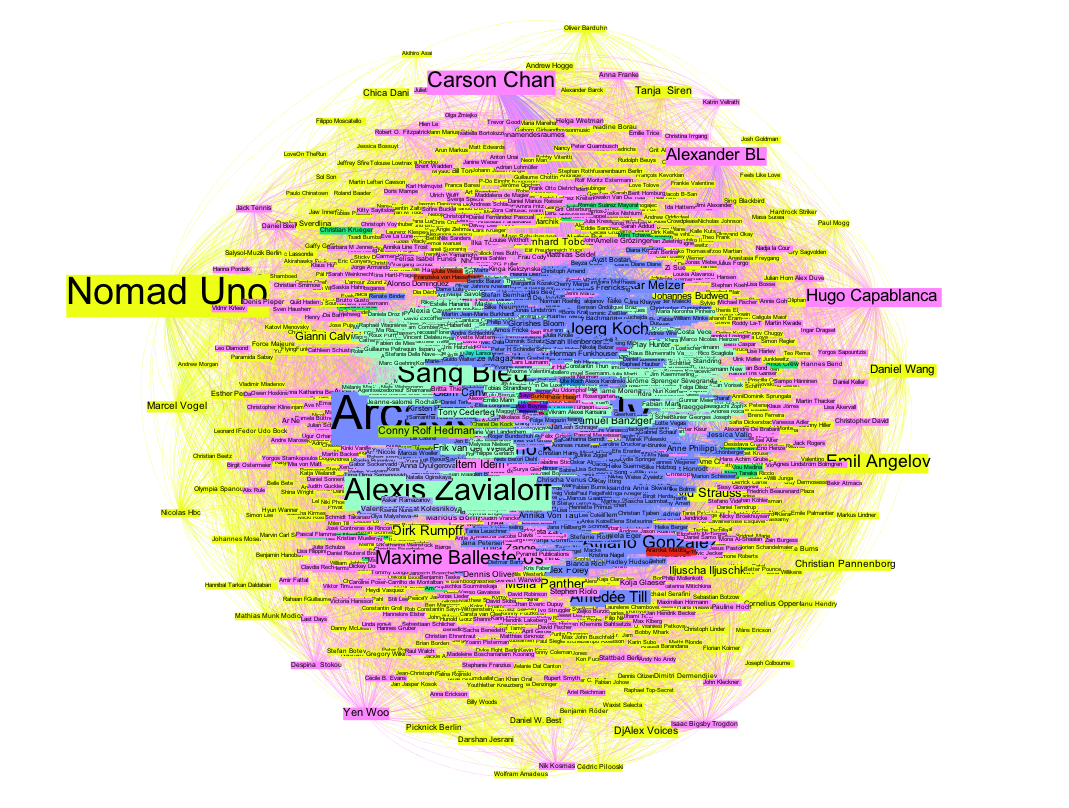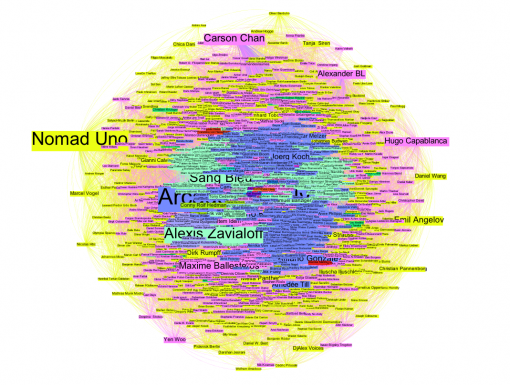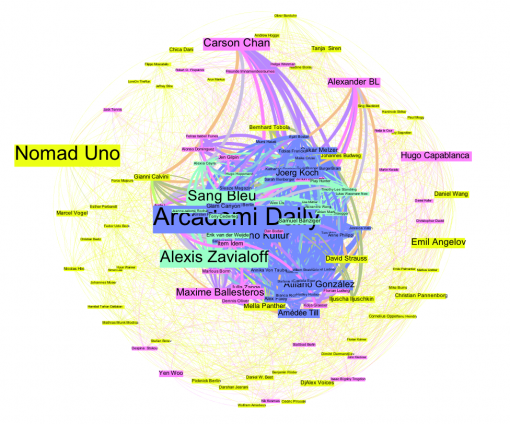Posted by Nodus Labs | April 24, 2012
Using Facebook Networks to Find Points of Access into Communities

Suppose you’re coming to a new city and you want to meet the community you like. Of course you’d probably ask your friends first, but what if you want to go beyond what your immediate surrounding can offer and explore a new group of people? Facebook can be a good tool for that and we’ll demonstrate that using a case from our practice as an example.
Client: PLAYBerlin platform
Objective: Find the key people in several local music and art groups in order to know more about what’s happening in their respective scenes.
For this job we were contacted by PLAYBerlin online music and arts platform to make analysis of three different music and art groups based in Berlin. Our objective was to find the most active people and to invite them to join PLAYBerlin network, so they could be informed about each others’ activity and post their news and events on PLAYBerlin.Com website. Knowing the most connected people in each group would also help PLAYBerlin to know who are the people generating most of the activity in the local scene.
The first step is to know what the actual communities should be. In this case, it was Vulkaandance – the group that organises monthly parties around the city, Ninety-Five – a small gallery-club, and 032c (the largest group) – the group associated with 032c art and culture bi-annual magazine published in Berlin. The interest here was to see how the local alternative music scene and the alternative art scene connect. What are the people that are interested in interactions between the groups in particular?
Approaching these groups is difficult, because there are more than 400 members in each, so it’s not easy to know who to contact first. Instead, we decided to identify the people who have the most connections both within their own group and also to the other groups analysed. This way we would find the individuals who are involved across the different communities and would most likely to be involved into PLAYBerlin project, which is an online platform connecting music, performance and contemporary dance.
We exported the groups data using NetVizz application and opened the graphs using Gephi visualisation software. The nodes in the graph designate the Facebook profiles and the connections are the friend links between them. A more precise analysis would also include some sort of measurement of communication intensity between the people in the network (e.g. the number of “likes” they recently left to each other’s content), however, in this case we were more interested in the structural properties of the network, rather than the functional ones.
In order to render the graph more readable, we applied ForcedAtlas layout, ranged the nodes according to their betweenness centrality (the higher the value, the more is the node’s relative influence in the network), and ran a community detection algorithm that shows the groups of nodes that are more densely connected to each other than to the rest of the network. We obtained this image as a result:
We then left only 5% (133 out of 2660) of the most connected nodes in order to have a clearer picture of influence in this network. This produced a more readable image of the most influential profiles for these three groups combined.
As we can see, there are four distinct communities in the three groups designated by different colors. The biggest one is the blue (most influential nodes are Arcademi – an online platform for art and design, Joerg Koch – the editor of 032c magazine), and Mono Kultur (another small art and fashion magazine from Berlin). The green one is smaller and the most influential nodes are Alexis Zavialoff (works for a popular art book distribution company Motto Berlin) and Sang Bleu (also publishing). The yellow one is mainly the music group from Vulcandance where the most influential nodes are Nomad Uno (a DJ) and Emil Angelov (another DJ). The pink group (Carson Chan – writer and journalist, Maxime Ballesteros – photographer) is very interesting, because they have connections across the different groups and play quite an important roles in bringing the communities together. Also Gianni Calvini is an important node in the network, as he connects the music and art communities together.
What can we do with this information?
1) We identified the 10 individuals among the initial 2500 people and can now contact them directly using Facebook message facility or its advertising service.
2) We also got a much better insight into the main interests that unify these communities. As we’ve seen, the art group that we were researching gravitated towards the people running the art magazine / distribution channels. The music group gravitated towards the DJs. The people who link those groups together are mainly the journalists and photographers who are probably involved into activities of all these groups to some extent.
3) We can use this information to make links between the groups, deliver the messages to these communities in a more focused way, as well as access the information that they distribute more efficiently.
The same approach can be used if you want to be quickly introduced to a new scene at a new city. Find a few groups you find interesting, identify the key members using some basic social network analysis, check out their profiles and contact them for more information. This is a fast and efficient way of scouring through very complex (and not easily available) information, that can help people connect bypassing the content filters imposed by Facebook. There is of course the question of privacy, but as we’re focusing on the most connected profiles here, it is likely that the individuals identified will be more or less public personas that welcome this sort of attention.



